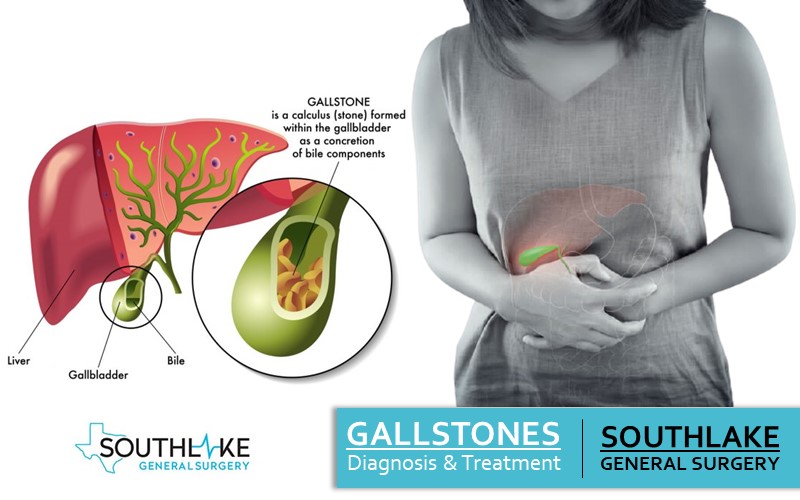To identify the gallstones symptoms your doctor may initially look at your skin for jaundice, and afterward feel your abdomen to check for tenderness. And a blood test to identify the symptoms.
Since various digestive issues, like an infection of the duct, can create symptoms like those of a gallstone attack, the doctor may likewise run different tests to decide whether gallstones are indeed the guilty party.
There are a few more tests that doctors can prescribe to examine gallstones. It includes Ultrasound – it is the most widely recognized procedure which is quick and painless to take pictures of the gallbladder. The doctor may use a CT scan on a few occasions to check the anatomy of internal organs.
There is another and most complicated procedure to identify the gallstone if the doctor presumes that a gallstone is held-up in a bile duct. This procedure is known as the ERCP test, which allows your doctor to view the bile duct through a small tube known as an endoscope. This procedure takes about an hour and the patient will be given sedative medication to forestall choking. Once the doctor passes the endoscope into the mouth through the stomach and into the small intestines where the bile duct enters, a dye is infused through the tube into the bile duct to take X-rays. This procedure also allows doctors to remove gallstones.
Treatments of Gallstones
In many cases, if an individual has symptoms of gallstones then the treatment of gallstones is recommended. There are many conventional treatments available and one of the most widely used gallbladder removal surgery and others are non-surgical treatments.
Medicines for gallstones treatment
With respect to symptoms and diagnosis of gallstones, doctors mainly choose to recommend three main treatment alternatives: Watchful waiting, non-surgical treatment, and gallbladder removal surgery (Cholecystectomy).
Watchful waiting for gallstones
In a few individuals, gallstones can be very painful or frightening, just about a third to half surprisingly who experience a gallstone attack never have a recurrence. Sometimes, the stone breaks down or gets ousted and maintains its Silence. Since the issue may address itself without intercession, many specialists like to adopt a wait-and-watch strategy following the initial stage.
In any event, if an individual has had recurring gallstones, the specialist may defer treatment or surgery due to other health issues. If an individual’s surgical procedure has been deferred, an individual should stay under a specialist’s care and report any repeats of gallstone indications right away.
What is the non-surgical treatment for gallstones?
If an individual can’t or is reluctant to go through surgery for gallstone issues, the doctor may suggest one of a few non-invasive procedures. However, these procedures may obliterate symptoms causing gallstones, they can never really keep others from developing, and repeat is normal.
A few gallstones can be disintegrated using a bile salt, albeit the strategy can be utilized uniquely with stones framed from cholesterol and not from bile pigments. The medication is taken as a tablet; contingent upon its size, the gallstone may require months or even an exceptionally long time to disappear. Since certain stones are calcified, this treatment might not work.
Another non-surgical procedure is shock wave treatment, which utilizes high-frequency sound waves to piece the stones. Bile salt is regulated a while later to dissolve small stone pieces. This treatment is occasionally utilized.
The doctor can likewise remove gallstones during an ERCP. During the treatment, an instrument is embedded through the endoscope to remove the gallstones.
While these treatments may work for a few, the entirety of the above non-surgical treatments are generally ineffective in the long haul and are seldom recommended in clinical practice.
Gallbladder Removal Surgery
The gallbladder has a significant role; however, it is not important for a healthy life. If gallstones create consistent problems and an individual encounter symptom, the doctor may suggest removing the gallbladder. Gallbladder removal surgery is one of the safest surgeries performed by our surgeon Dr. Valeria Simone MD, at Southlake General Surgery, Texas.
Once the gallbladder is removed, bile flow moves directly from the liver into the small intestine, and this occasionally prompts diarrhea. Since bile no longer collects in the gallbladder, the amount of digestive fluid can’t be kept and used to break down a particular fatty diet. It is not a serious condition, but it can be resolved by restricting fat in the daily diet.
Earlier, gallbladder surgery was done through customary “Open Surgery”, wherein the surgeon makes one large incision in the abdomen to access the gallbladder. In this surgery, recovery is longer, and the patient must stay in the hospital for a few days after surgery.
Medical advancement in recent years has allowed general surgeons to use Laparoscopic gallbladder removal surgery instead of conventional surgery. In Laparoscopic surgery, the surgeon makes a few small incisions in the abdomen to insert the laparoscope and other special surgical tools to remove the gallbladder. This procedure is also known as a minimally invasive method, which includes fewer scars, less pain, and faster recovery. The patient can be discharged the same day after the surgery, and he/she can resume normal activities in about 2 weeks. Laparoscopic gallbladder removal surgery at Southlake General Surgery is one the safest surgical procedure. Individuals who are overweight or who have serious infection or inflammation in the gallbladder may, in any case, be viewed as a possibility for customary Open Surgery for the gallbladder.
Appointment
For more information on Gallstone Diagnosis and Treatment at Southlake General Surgery, Texas and consultation. Please contact our healthcare expert today at +1(817) 748-0200.

